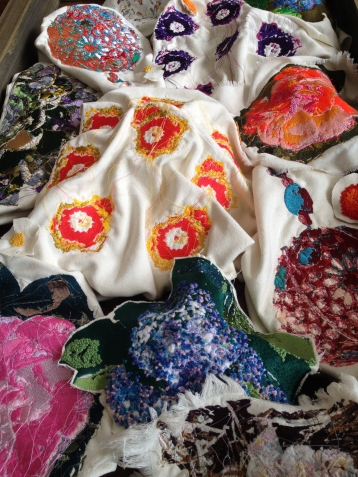Discovering the Space Between: C. Pazia Mannella and Tamsen Wojtanowski
AN ESSAY BY JILLIAN MATTHEWS
As the stars illuminate and move through a dark sky as night falls or a summer breeze rustles the delicate petals of a flower in bloom, memories of experiences are not static, but constantly shifting. As time passes, perspectives change; memories evolve, or simply fade away. Artists Tamsen Wojtanowski and C.Pazia Mannella capture the ephemerality of memory in their shared exhibition at NAPOLEON, Inside Voices. Each piece included in the exhibition functions as a visual autobiography by which both Tamsen and Pazia express their intimate accounts of the everyday. Both artists have unfolded their internal lives and intimate relationships and have reflectively responded to collecting various ephemera from exchanges with their respective companions. These private archives serve as a source of inspiration and discovery and range from thoughtfully written letters to spontaneous photos shared via text. Though the two bodies of work on exhibit are distinctly different, each artist explores universal notions of love, longing, uncertainty, and commitment.Inside Voices shows a dichotomy that reflects on the comforts of domesticity and the beauty of sharing your daily life with another, but also the fear of an unknowable future, and the fleeting nature of recollection.
Our memories are precious because they provide us with a link to the past, to knowledge and meaning. Today we frequently attempt to preserve a moment by snapping a photo on our camera phones or sharing personal experiences through social media outlets. However, our most intimate memories are often those that affect us most deeply. Philosopher John Sutton initiates a discourse on the role of memory in our daily lives stating “Remembering is often suffused with emotion, and is closely involved in both extended affective states such as love and grief, and socially significant practices such as promising and commemorating” (Sutton).Our recollections of love and loss, our experiences of personal and collective events, our sentimental longing for home, all continually form our perspectives on the present. Time quickly passes us by, and we are left to decipher the sometimes ambiguous residue that it leaves behind.

Tamsen Wojtanowski, I/You/We, 8” x 10” Silver Gelatin Prints, Masonite, Wood. 5′x5′ grouped installation, 2014
Tamsen Wojtanowski’s series of Photograms titled “I/You/We” considers a yearning for a sense of home and the physical absence of her partner. Gazing into the night sky, stars pierce through the darkness. With each night, configurations of constellations shift into new views. It takes years for even the closest star’s light to reach the earth. Every night as we look up into a clear sky, we share in the history of the universe, both together and alone. Wojtanowski calls on the paradox of this shared experience by visually closing the physical distance between the artist and her partner in her series. By employing an antique printing process called Cliché Verre, Latin for “glass picture”, the artist creates a handmade negative. The technique involves carefully painting the glass and then exposing it to light. The light penetrates the unpainted portions creating the final print, known as a Photogram. Using this intuitive process the artist reinvents the private letters exchanged between her and her partner. Wojtanowski creates a pattern based on the unique locations of only the words “I”, “You” and “We” penned in each of the letters. The resulting Photogram dissolves into darkness, revealing only the “light” of the words I, You and We. What emerges from this process is veiled and mysterious, a kind of unbreakable semantic code. Each individual print maintains the intimate scale of the original letters, but functions as a pixel in a larger image. The installation of the series standing 5 feet high and 5 feet wide is a unified presence in the small scale of the NAPOLEON Gallery. The piece evokes the essence of the vacuous beauty of the cosmos, but also underscores the mystery of what lies ahead and the volatility of memory itself.
Standing apart from this series are also two photographs, both aptly titled “home” and “Home”, drawing the viewer back into the seemingly mundane routines of the everyday. The artist offers abbreviated and sometimes voyeuristic glimpses into her private domestic environments. However, with little context the images are ambiguous and pose questions regarding place and time, blurring the lines between moment and memory. Wojtanowski’s body of work reflects on both the anticipation and vulnerability of a growing relationship and the longing for physical and psychological refuge in a chaotic world. When viewed collectively the pieces transport the viewer to that liminal space between the past and the more recent present.
Perception and time are central concepts in the material-based work of C. Pazia Mannella. Her floor installation titled“Force” recalls the beauty of an urban garden contained- a meticulously manicured natural oasis in the midst of a harsh concrete city. Mannella’s unnatural garden “grows” from the center of the gallery floor contained within a large wooden flower box. At first glance Mannella’s painterly garden appears to be a delightful installation juxtaposed against the stark white walls of the gallery. However, the embroidered blooms belie the fact that these vibrant flowers could never exist harmoniously in nature.
Mannella, who has taken a strong interest in horticulture considers the practice of forced blooming, a process in which plants are grown in greenhouses and forced to bloom prior to their natural growth cycles. By subverting our notions of “natural” beauty, the artist initiates a dialogue about our voracious desire for the harmony and tranquility of the natural world and the tensions which lie just beneath the surface of this yearning.
Similar to artist Tamsen Wojtanowski’s body of work, Mannella’s work fluctuates between the tangible and the ethereal with her piece titled “Trace”. A panel of white silk, printed with a subtle light blue watercolor quietly hangs from the wall at the back of the gallery. A ghostly, corporal image seems to emerge from the silk in the likeness of two arms clasped together, one seemingly vanishing from sight. Faint white embroidery can be seen carefully defining edges, and then it too fades away into the folds of the silk. The haunting quality of the print reminds us of the fading light of memory as time passes and our sometimes futile attempts to preserve it.
Inside Voices oscillates between the commonplace and the otherworldly, between the idyllic and the weight of an uncertain future. It provides a striking visual contrast between the enigmatic imagery presented in Wojtanowski’s black and white prints and photographs and the rich textures and vibrant colors woven throughout Mannella’s embroidered textiles. The pairing of the works calls the viewer to the threshold that exists between tangible realities and the dreamlike quality of memories. The artists each reflected on their own personal archives, laying bare the complex relationships between the past, the present. Inside Voices provokes questions about what it means to remember, while living in a fast paced and often transient contemporary world.In an age where we have the capability to record our daily lives at our finger tips and the access to massive amounts of digital memory, forgetting may not be our greatest fear, but perhaps it is the fear of being forgotten by the ones we love most.
Bibliography
Mannella, C. Pazia. Artist Interview. 22 February 2014.
Sutton, John, "Memory", The Stanford Encyclopedia of Philosophy (Winter 2012 Edition), Edward N. Zalta (ed.), URL = <http://plato.stanford.edu/archives/win2012/entries/memory/>.
Wojtanowski, Tamsen. Artist Interview. 22 February 2014.
About the Author:
Jillian Matthews is an artist and designer. She received her MFA in Jewelry and Metals
from the Rhode Island School of Design in 2013. She currently lives in Philadelphia
and works as an Installation Design Assistant at the Philadelphia Museum of Art.
For more information please visit http://www.behance.net/JillianMatthews.
from the Rhode Island School of Design in 2013. She currently lives in Philadelphia
and works as an Installation Design Assistant at the Philadelphia Museum of Art.
For more information please visit http://www.behance.net/JillianMatthews.




No comments:
Post a Comment